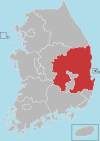Gyeongsan
Gyeongsan
경산 | |
|---|---|
| Korean transcription(s) | |
| • Hangul | 경산시 |
| • Hanja | 慶山市 |
| • Revised Romanization | Gyeongsan-si |
| • McCune-Reischauer | Kyŏngsan-si |
 | |
 Location in South Korea | |
| Country | |
| Region | Yeongnam |
| Administrative divisions | 2 eup, 6 myeon, 6 dong |
| Area | |
| • Total | 411.58 km2 (158.91 sq mi) |
| Population (December 31, 2009) | |
| • Total | 236,459 |
| • Density | 574.52/km2 (1,488.0/sq mi) |
| • Dialect | Gyeongsang |
Gyeongsan is a city in North Gyeongsang Province, South Korea. Its western border abuts the metropolitan city of Daegu, and much of Gyeongsan lies within the Daegu metropolitan area.
Numerous universities are located in Gyeongsan, such as Yeungnam University, Daegu University, Catholic University of Daegu and Gyeongil University.
Symbols of City
The city flower is the magnolia which grows well even in poor soil conditions. The city bird is the magpie. Its clear song reflects the bright and hopeful spirits of citizens. The city tree is the ginkgo. It symbolizes the constant prosperity, perseverance and elegant traits of Gyeongsan citizens.[1]
International Chemistry Olympiad
Gyeongsan was the host for the 38th International Chemistry Olympiad (2 July 2006 - 11 July 2006).
Sister cities
Gyeongsan has five sister cities:
Administrive districts
- Hayang Eup (하양읍)
- Jillyang Eup (진량읍)
- Wachon-myeon (와촌면)
- Jain-myeon (자인면)
- Yongseong-myeon (용성면)
- Namsan-myeon (남산면)
- Apyang-myeon (압량면)
- Namcheon-myeon (남천면)
- Jungang-dong (중앙동)
- Dongbu-dong (동부동)
- Seobu1-dong (서부1동)
- Seobu2-dong (서부2동)
- Nambu-dong (남부동)
- Bukbu-dong (북부동)
- Jungbang-dong (중방동)[2]
Location
Gyeongsan city lies mid-western part of Gyeongsangbuk-do. It is close to several big cities such as Daegu, Ulsan, Busan and many other places.
Climate
The climate is mild because of its southern location. However, being landlocked makes its climate continental.
The amount of rainfall is less than the average yearly rainfall of Korea, due to its geographical characteristics.[3]
See also
References
- ^ Gyeongsan Symbols, Gyeongsan City
- ^ <Original data from city webpage
- ^ welcome to Gyeongsan City Hall


